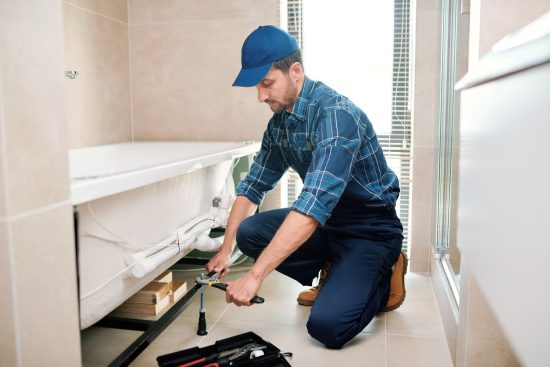A bathtub is typically going to be one of the most durable and long-lasting installations in your home, but nothing lasts forever. Over time, even the best bathtub may start to develop problems. The occasional issue is fine, and bathtub repair is often fairly easy – but eventually, too many problems mean it’s probably time to replace the tub.
So, what are common fixable problems with bathtubs, and what problems indicate you may want to look into buying a new bathtub? Roto-Rooter California is here to help!
I. Common Bathtub Repairs
1. Faucet Leaks

Any water-bearing fixture is going to develop leaks every now and then. Fortunately, these are usually easy to fix. Most of the time, if a tub’s faucet is leaking, it’s just due to a bad washer or O-ring inside. Most tub faucets are built to be disassembled, just by removing a couple of screws in the base. Once you’re inside, simply swapping out the O-ring or washer will usually take care of the problem.
However, it’s also possible the problem lies in the faucet’s valve mechanism controlling water flow. If that breaks down, you don’t need a new tub, but you do need new faucets.
2. Drain Leaks
The other most common source of bathtub leaks is the drain. Rather than washers, the drain relies on a plumber’s putty (a kind of waterproofed caulk) to maintain a watertight seal. However, this putty can also harden and crack over time.
So, much of the time, fixing a drain leak is as easy as pulling up the drain cover and applying more plumber’s putty.
However, if the problem isn’t at the drain itself, it’s probably an issue with the pipes below. In this case, replacing the tub won’t help. You just need to call in experienced plumbers to fix the leak, and you should be good to go.
3. Mold
If a bathtub isn’t kept clean, it can easily develop mold or mildew. The difficulty of this bathtub repair job mostly depends on how much mold and mildew there is.
Most of the time, the mold begins growing in the caulk around wall tiles, or around the base of the tub. If the infestation isn’t too bad, you may be able to use a strong cleaner such as bleach or hydrogen peroxide (but NOT both at the same time!) to kill the mold. You may also need to remove the infested caulk manually and replace it with new caulk.
Likewise, if mold has started growing on the bottom of the bathtub, bleach or hydrogen peroxide can often kill it off.
However, if the mold problem is too bad, replacing the tub may be necessary. In these cases, you may also want to call in a water damage restoration specialist with experience handling mold, to make sure it hasn’t spread into the walls or other places near the bathtub.
II. Other Signs That It’s Time to Replace the Bathtub
Aside from mold infestations – which may or may not be easily fixable – what other problems with your bathtub may suggest you need a replacement?
1. Chips, cracks, and other structural damage
Physical damage to a bathtub is hard to repair. In the case of very small cracks, you may be able to use waterproof epoxy to fill in the chip or crack and maintain the water seal. Unfortunately, this fix won’t last forever, and it’ll be visible whenever you use the tub. Also, cracks have a tendency to get bigger over time, so a small problem will eventually turn into a big problem.
Most of the time, once a bathtub starts developing physical damage, it’s time to look at replacing it.
2. Frequent leaks
As mentioned above, seals such as washers and O-rings will wear out over time and will periodically need to be replaced. However, this shouldn’t happen more than once a year, and probably much less. If your bathtub is frequently springing leaks, that suggests its structural integrity is failing, or that there are serious plumbing problems involved.
In this case, the costs of constant repairs and leak fixes will soon outweigh the cost of a new bathtub. Plus, it’s so nice having a beautiful new tub, not a broken one that’s constantly springing leaks.
3. Stubborn stains
Aside from mold and mildew, a well-used tub is prone to developing stains over time. The best way to deal with this is to be vigilant about cleaning your bathtub, so stains and grime don’t have time to set in. However, if the tub isn’t well-maintained, it can easily get to the point that stains are difficult or impossible to remove.
This doesn’t inhibit use of the tub, but it is kind of gross – and you’d probably be happier with a pristine tub that doesn’t have a dirty floor or stains along the water line.
4. Accessibility issues
Typical bathtubs aren’t built for people with mobility issues. They usually require a high step to enter, and often lack rails and other handholds. If you or someone in your household has mobility issues, replacing the tub with a handicapped-accessible model is a very good idea.
These tubs include multiple handrails for safety, as well as using a sealed swinging door to enter the tub, rather than requiring you to step over the edge. In this case, replacing the tub isn’t just a matter of convenience. Disability-friendly bathtubs can genuinely prevent accidents, and even save lives.
Roto-Rooter Is Here to Maintain Your Bathroom
Roto-Rooter are California’s bathroom plumbing experts! From simple drain cleanings or leak fixes to full installations of new bathtubs and other fixtures, we do it all. Our plumbers are highly trained and immaculately professional, ready to help you with any bathtub repair, big or small.
We’re available 24/7 for emergency calls too! So, whenever you need bathroom plumbing, all you need to do is Contact Roto-Rooter ASAP or call us at 800-491-ROTO.
